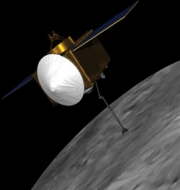NASA’s OSIRIS-REx spacecraft catches its first glimpse of its target Bennu asteroid
NASA’s asteroid sampling spacecraft OSIRIS-REx has captured first images of its target asteroid Bennu and began its final approach towards it after almost two-year journey. OSIRIS-Rex stands for Origins, Spectral Interpretation, Resource Identification, Security-Regolith Explorer. The first glimpses of targeted asteroid were captured by PolyCam camera OCAMS on board of OSIRIS-Rex from a distance of 2.1 million kilometre. It will help to study Bennu’s size, shape, surface features, and surroundings.
OSIRIS-Rex
OSIRIS-Rex mission was launched in September 2016 for studying 101955 Bennu, a carbonaceous asteroid. It is NASA’s first asteroid sampling mission i.e. it will survey surface, collect sample and deliver it safely back to Earth. So far, it has travelled approximately 1.8 billion kilometres since its launch. During its approach phase, OSIRIS-REx will regularly observe area around the asteroid to search for dust plumes and natural satellites and study its light and spectral properties.
The spacecraft is scheduled to reach small, roundish asteroid in 2018 and return to Earth after collecting some of its gravels by 2023. OSIRIS-Rex will capture 60 grams dirt and debris from surface of asteroid using its robotic arm without landing i.e. by hovering like hummingbird stirred up by nitrogen gas thrusters and then to Earth for detailed analysis of the collected samples.
After arrival at Bennu, OSIRIS-Rex spacecraft will spend first month performing flybys of asteroid’s northpole, equator and south pole at distances ranging between 19 and 7 kilometres from it. These manoeuvres will allow for first direct measurement of Bennu’s mass as well as close-up observations of surface. These trajectories will also provide the mission’s navigation team with experience navigating near the asteroid.
Bennu
Bennu is near-Earth carbonaceous asteroid about the size of a small mountain in the Apollo group. It was discovered in September 1999 by the LINEAR Project. It is carbon-rich asteroid and believed to be the type of asteroids that may have chemical building blocks of life, along with lots of water. So, analysis of returned sample from it could help to reveal key insights about early solar system and the origin of life on Earth. It is potentially hazardous asteroid and there is very slight chance it could strike into Earth in the late 22nd century.
Month: Current Affairs - August, 2018


